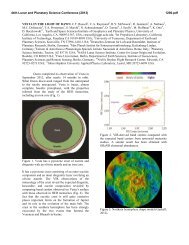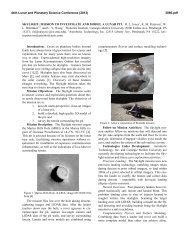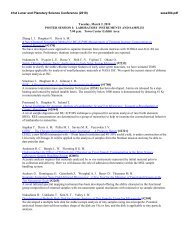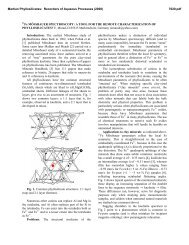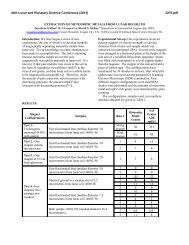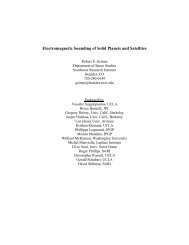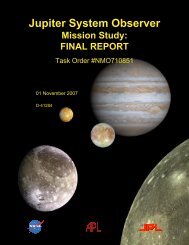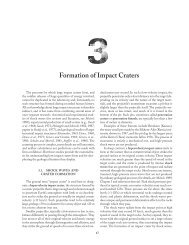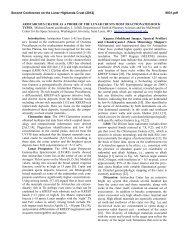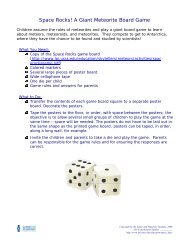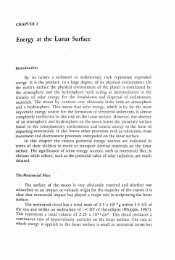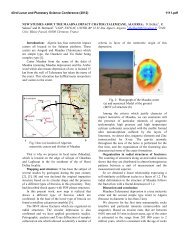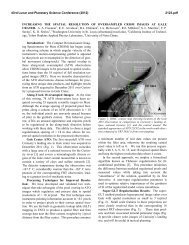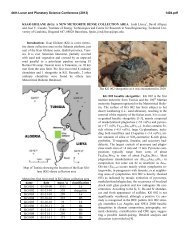Plymouth Rock: An Early Human Asteroid Mission Using Orion
Plymouth Rock: An Early Human Asteroid Mission Using Orion
Plymouth Rock: An Early Human Asteroid Mission Using Orion
Create successful ePaper yourself
Turn your PDF publications into a flip-book with our unique Google optimized e-Paper software.
<strong>Plymouth</strong> <strong>Rock</strong>:<br />
<strong>An</strong> <strong>Early</strong> <strong>Human</strong> <strong>Asteroid</strong><br />
<strong>Mission</strong> <strong>Using</strong> <strong>Orion</strong><br />
Lockheed Martin Proprietary<br />
Information<br />
Presented to the<br />
Small Bodies Assessment Group<br />
November 2009<br />
Josh Hopkins, Adam Dissel<br />
Lockheed Martin Space Systems Company 1
Study Background<br />
• Lockheed Martin began investigating asteroid<br />
missions using <strong>Orion</strong> in 2007<br />
– Our study focused on how to perform an asteroid<br />
mission as a complement to the baseline Constellation<br />
Program’s s lunar mission plans. Some details may<br />
change if NASA’s s baseline changes but the results are<br />
broadly applicable.<br />
• The results presented here are based on internally<br />
funded research, and do not imply endorsement<br />
by NASA or any change in program plans for the<br />
<strong>Orion</strong> crew exploration vehicle or the<br />
Constellation Program<br />
2
A New Destination for <strong>Human</strong><br />
Spaceflight<br />
• In the past ten years, astronomers have<br />
discovered dozens of asteroids in Earth-like orbits<br />
– Discoveries are continuing and accelerating<br />
• Some of these new asteroids are accessible with<br />
lunar-class exploration spacecraft and launch<br />
vehicles, rather than Mars-class systems<br />
• These recent discoveries are so new that the<br />
implications for human spaceflight of are still<br />
being determined and are not incorporated in<br />
prior spaceflight planning<br />
– <strong>Asteroid</strong>s used to be the “beyond” in “Moon, Mars and<br />
Beyond,” but now they could be “Moon, Mars and<br />
Between” or perhaps even “Before”<br />
3
<strong>Asteroid</strong> Orbits<br />
• Main Belt <strong>Asteroid</strong>s (~450,000 known)<br />
Most asteroids, like Ceres, , orbit far<br />
beyond Mars and are not yet<br />
accessible for human missions<br />
• Near Earth <strong>Asteroid</strong>s<br />
(~6000 known) Some<br />
asteroids, like Eros, , are<br />
nudged into elliptical orbits<br />
in the inner solar system.<br />
They approach Earth, but at<br />
high speed, so they are still<br />
difficult to visit<br />
• Accessible <strong>Asteroid</strong>s (dozens)<br />
A small fraction of the Near Earth<br />
<strong>Asteroid</strong>s, like 2008 EA9, , are in Earth-<br />
like orbits. They are close and their<br />
velocity relative to Earth is small,<br />
making easy round trips possible<br />
1 A.U.<br />
2 A.U.<br />
3 A.U.<br />
2008 EA9<br />
Eros<br />
Ceres<br />
4
Earth’s Known Neighbors, circa 1990<br />
Era of Space Exploration Initiative, Stafford & Augustine Reports<br />
0.125<br />
(No Known Orbital Neighbors)<br />
0.1<br />
Eccentricity<br />
0.075<br />
0.05<br />
0.025<br />
<strong>Asteroid</strong> Inclinations<br />
i < 1<br />
1< i < 2<br />
2< i < 3<br />
3 < i < 5<br />
EARTH & MOON<br />
Region of<br />
Accessible Orbits<br />
0<br />
0.9 0.95 1 1.05 1.1<br />
<strong>Asteroid</strong>s known as of year-end 1990<br />
Glyph size proportional to asteroid size (5-75 m)<br />
(Earth not to scale)<br />
Semi-Major Axis (A.U.)<br />
Image of Earth and Moon from Deep Impact, courtesy NASA<br />
Mars at<br />
1.5 A.U.<br />
5
Earth’s Known Neighbors, circa 2003<br />
Columbia Accident, Vision for Space Exploration Formulated<br />
0.125<br />
2000 LG6<br />
0.1<br />
1999 AO10<br />
2001 QJ142<br />
Eccentricity<br />
0.075<br />
0.05<br />
<strong>Asteroid</strong> Inclinations<br />
2000 SG344<br />
2001 GP2<br />
1991 VG<br />
0.025<br />
i < 1<br />
1< i < 2<br />
2< i < 3<br />
Region of<br />
Accessible Orbits<br />
3 < i < 5<br />
EARTH & MOON<br />
0<br />
0.9 0.95 1 1.05 1.1<br />
<strong>Asteroid</strong>s known as of autumn 2003<br />
Glyph size proportional to asteroid size (5-75 m)<br />
(Earth not to scale)<br />
Semi-Major Axis (A.U.)<br />
Image of Earth and Moon from Deep Impact, courtesy NASA<br />
Mars at<br />
1.5 A.U.<br />
6
Earth’s Known Neighbors, July 2009<br />
Era of Second Augustine Committee<br />
0.125<br />
0.1<br />
2008 DL4<br />
2004 QA22<br />
2000 LG6<br />
1999 AO10<br />
2007 YF<br />
2007 DD<br />
2003 WP25<br />
2006 BZ147<br />
2008 JL24<br />
Eccentricity<br />
0.075<br />
0.05<br />
0.025<br />
<strong>Asteroid</strong> Inclinations<br />
i < 1<br />
1< i < 2<br />
2< i < 3<br />
3 < i < 5<br />
2003 YN107<br />
2007 VU6<br />
2000 SG344<br />
2006 QQ56<br />
2008 KT<br />
2006 JY26<br />
1991 VG<br />
2009 BD<br />
2001 GP2<br />
2006 RH120<br />
EARTH & MOON<br />
2008 UA202<br />
2008 EA9<br />
2007 UN12<br />
2001 QJ142<br />
2008 HU4<br />
Region of<br />
Accessible Orbits<br />
0<br />
0.9 0.95 1 1.05 1.1<br />
<strong>Asteroid</strong>s known as of summer 2009<br />
Glyph size proportional to asteroid size (5-75 m)<br />
(Earth not to scale)<br />
Semi-Major Axis (A.U.)<br />
Image of Earth and Moon from Deep Impact, courtesy NASA<br />
Mars at<br />
1.5 A.U.<br />
7
What are these objects?<br />
• Small asteroids (5-70 meter sized) in Earth-like orbits<br />
– The smallest are mostly harmless, but the largest are similar in<br />
size to the impactors which caused the Tunguska Event and<br />
Barringer Crater<br />
• Origin and composition of these objects are uncertain<br />
– Small size makes them hard to study telescopically<br />
– Arrived in these orbits within the last 100,000 years<br />
– Mostly shattered remnants of larger asteroids in the main belt<br />
which migrated to closer orbits<br />
– A few might be defunct spacecraft, burned out comets, or even<br />
ejecta from recent lunar craters<br />
– Spin rates are undetermined for most of these objects, but the<br />
few known spin rates are very fast (a few minutes per rev)<br />
• Likely to be monolithic rather than ‘rubble piles’<br />
8
Why Explore an <strong>Asteroid</strong>?<br />
• Knowledge<br />
– Study formation and history of our solar system<br />
– Correlate asteroid families to meteorite samples<br />
• Security<br />
– Enable deflection of future hazardous impactors by understanding<br />
structure, composition, and how to operate around small asteroids<br />
• Wealth<br />
– Evaluate viability of asteroid resources for human expansion in<br />
space<br />
• National Pride<br />
– Decisively re-establish establish American preeminence in space<br />
– Reduce the ‘exploration gap’ before the next human lunar landing<br />
• Training<br />
– If a lunar mission precursor: Demonstrate lunar launch profile,<br />
LEO rendezvous, and <strong>Orion</strong> reentry at lunar-like like entry speeds<br />
– As a Mars mission precursor: Learn to fly human missions in deep<br />
space, with speed of light lag, radiation risk, and no resupply or<br />
rescue. <strong>Asteroid</strong>s are shorter, simpler practice for Mars missions.<br />
s.<br />
9
How Can We Explore the <strong>Asteroid</strong>s?<br />
• Favorable orbital alignments occur only a few times<br />
per decade, so it may not make sense to design a<br />
new human spacecraft just for asteroid missions<br />
• <strong>Orion</strong> can be used to launch and return astronauts,<br />
but these missions need an additional spacecraft<br />
craft<br />
element to provide more deep-space propulsion,<br />
living space, food, water, and oxygen<br />
• A second, modified <strong>Orion</strong> can be the additional<br />
element<br />
ent, , rather than investing in new spacecraft<br />
– Provides capability and substantial<br />
redundancy at low cost<br />
and within schedule timeframe without a new program start<br />
– Altair lunar lander may be an alternative depending on<br />
budget and design details (e.g. if boiloff rate < 0.25%/day)<br />
10
<strong>Mission</strong> Concept Utilizing Dual <strong>Orion</strong>s<br />
<strong>Asteroid</strong> Arrival<br />
Maneuver<br />
<strong>Asteroid</strong> Exploration<br />
(~5 days)<br />
Trans Earth<br />
Injection<br />
LEO<br />
Rendezvous<br />
Earth<br />
Departure<br />
Outbound<br />
Transfer<br />
(~ 3 months)<br />
Return<br />
(~ 3 months)<br />
LEO<br />
Re-entry<br />
Ares V Launch<br />
Supplemental<br />
<strong>Orion</strong> + EDS<br />
(Unmanned)<br />
Ares I Launch<br />
Primary <strong>Orion</strong><br />
(Manned)<br />
Recovery<br />
• <strong>Plymouth</strong> <strong>Rock</strong> asteroid mission architecture mimics baseline<br />
Constellation lunar mission profile except:<br />
– Supplemental <strong>Orion</strong> replaces Altair lunar lander<br />
– <strong>Asteroid</strong> target replaces Moon<br />
– Crew of two rather than four due to limited volume and supplies<br />
11
<strong>Asteroid</strong> Exploration Operations<br />
• We can’t ‘land’ or ‘moonwalk’ on an asteroid this small.<br />
Instead, spacewalk next to it, somewhat analogous to<br />
satellite servicing missions of the 1980s.<br />
• First, rendezvous with the asteroid and observe from several<br />
km away for basic mapping and to look for co-orbiting<br />
orbiting<br />
debris<br />
• Then, approach closer and station keep ~100 meters away<br />
– Keeping the spacecraft some distance from the asteroid rather<br />
than landing simplifies power, communications, thermal, GNC,<br />
etc.<br />
• Depressurize<br />
one <strong>Orion</strong> crew module to perform spacewalks s<br />
• Use an MMU-like spacesuit propulsion system to approach<br />
an asteroid and collect samples<br />
• Small asteroids likely have negative surface gravity due to<br />
rapid rotation periods<br />
– Makes EVA operations challenging<br />
– Probably means these asteroids don’t t have loose gravel or<br />
regolith that would be easy to sample<br />
• Many open questions are still to be resolved regarding how<br />
to perform EVAs near asteroids<br />
12
<strong>Asteroid</strong> <strong>Mission</strong> Opportunities 2015-2030<br />
2030<br />
<strong>Using</strong> Dual <strong>Orion</strong> or <strong>Orion</strong> + Altair<br />
<strong>Asteroid</strong> Launch Date Diameter<br />
<strong>Mission</strong> Duration for Various Propulsion Capabilities<br />
Prime <strong>Orion</strong> 25% More<br />
<strong>Orion</strong> + Altair<br />
Full Prop Prop in Each<br />
(estimate)<br />
Load <strong>Orion</strong><br />
Prime <strong>Orion</strong><br />
Offloaded for<br />
Ares 1<br />
2008 HU4 Apr 2016 7-10 m Not feasible 190 days 115 days 95 days<br />
1991 VG Jul 2017 6-9 m 230 days 220 days 190 days 175 days<br />
2008 EA9 Nov 2019 8-12 m 205 days 190 days 175 days 165 days<br />
2007 UN12 Jul 2020 5-8 m 235 days 230 days 215 days 210 days<br />
1999 AO10 Aug 2025 50-70 m Not feasible Not feasible Not feasible Not feasible<br />
2008 JL24 Feb 2026 4-5 m Not feasible Not feasible Not feasible 205 days<br />
2006 RH120 Jun 2028 4-5 m 165 days 145 days 115 days 95 days<br />
2000 SG344 Jul 2029 30-45 m 155 days 145 days 130 days 125 days<br />
• Six months appears to be the upper limit of feasible mission durations<br />
using dual <strong>Orion</strong><br />
• Longer missions are difficult due to radiation, limited habitable<br />
volume, life support consumables, etc.<br />
• Shorter missions are better<br />
• Repeat opportunities with a specific asteroid are usually decades s apart<br />
• At the current asteroid discovery rate, the number of known mission<br />
ion<br />
opportunities in this time frame may double by 2015<br />
13
2019 Opportunity: 2008 EA9<br />
2019 Opportunity to <strong>Asteroid</strong> 2008 EA9<br />
Total <strong>Mission</strong> DV = 4.9 km/s<br />
Total 205 Day <strong>Mission</strong> Duration<br />
2008 EA9 Orbit<br />
Earth Orbit<br />
Landing<br />
June 7, 2020<br />
Return Transfer<br />
106 Days<br />
Departure<br />
Feb 22, 2020<br />
Launch<br />
Nov 15, 2019<br />
Arrival<br />
Feb 17, 2020<br />
5 days at<br />
NEO<br />
Outbound Transfer<br />
94 days<br />
Heliocentric-Ecliptic Coordinate System<br />
Distance in km x 10 8<br />
14
2019 Opportunity: 2008 EA9<br />
2019 Opportunity to 2008 EA9<br />
Total <strong>Mission</strong> DV = 4.9 km/s<br />
Total 205 Day <strong>Mission</strong> Duration<br />
Moon Orbit<br />
Earth Departure<br />
3.305 km/s<br />
Atmospheric Entry<br />
11.12 km/s<br />
Return Transfer<br />
106 Days<br />
Max Distance from Earth<br />
= 12.2 million km<br />
= 32 x lunar distance<br />
= 0.08 A.U.<br />
= 40 light-seconds<br />
2008 EA9<br />
at Launch<br />
Outbound<br />
Transfer<br />
94 days<br />
2008 EA9<br />
at Landing<br />
<strong>Asteroid</strong> Arrival<br />
Maneuver<br />
0.44 km/s<br />
Trans-Earth<br />
Injection<br />
1.15 km/s<br />
Trajectory Tick Marks<br />
in 15 Day Increments<br />
Geocentric-Ecliptic Coordinate System<br />
15
Initial Feasibility Assessment<br />
• Two <strong>Orion</strong>s together provide just enough<br />
habitable volume for two astronauts<br />
• Dual <strong>Orion</strong>s can accommodate additional food,<br />
water, and oxygen needed for two people on 180<br />
day missions within volume and mass limits<br />
– The crewed <strong>Orion</strong> launch is mass constrained by launch<br />
performance and the capability of the launch abort<br />
system and recovery system. Therefore, most of the<br />
additional consumables are launched in the<br />
supplemental <strong>Orion</strong><br />
– Consumables are budgeted and allocated to support an<br />
emergency return using either <strong>Orion</strong> alone<br />
– Waste and trash management are a challenge<br />
16
Initial Assessment, continued<br />
• Two <strong>Orion</strong>s have just enough propellant to reach the easiest<br />
asteroids<br />
– Currently estimating 0.6 km/s ∆V available from supplemental <strong>Orion</strong> for<br />
asteroid arrival maneuver when both <strong>Orion</strong>s are mated, and 1.0-1.21.2<br />
km/s ∆V from primary <strong>Orion</strong> alone for Trans-Earth Injection<br />
– Budget for LEO insertion, flight performance reserve, trajectory<br />
correction maneuvers, and launch windows accounted for separately<br />
• Reentry velocity is similar to lunar return<br />
– Reentry velocities are 11.05 to 11.25 km/s for asteroid missions, vs 11.0<br />
km/s for lunar return<br />
– TPS enhancement may be required depending on the ultimate<br />
capability of <strong>Orion</strong> lunar TPS<br />
• On-going technical assessment is in work at Lockheed<br />
Martin<br />
– Issues being addressed include radiation exposure risk, EVA<br />
operations, contingency return trajectories<br />
17
Launch Vehicle Needs<br />
• <strong>Orion</strong>-based asteroid missions require launch of<br />
about 46 tons to C3 = +1 to +4 km 2 /s 2 (slightly faster<br />
than escape velocity)<br />
– This is roughly equivalent to launching 50-65 mt to trans-<br />
lunar injection (C3 = -1.8 km 2 /s 2 ) depending on the launch<br />
approach<br />
– This could be achieved using several possible launch<br />
architectures<br />
– The planned Ares V capability has margin for this mission<br />
– Ares I performance (in combination with Ares V) is<br />
sufficient for some launch opportunities, but increased<br />
performance would allow <strong>Orion</strong> propellant tanks to be fully<br />
loaded, enabling more opportunities and reducing mission<br />
duration<br />
• <strong>Asteroid</strong> missions using <strong>Orion</strong> and Ares are mainly<br />
limited by factors other than launch, such as reentry<br />
velocity and spacecraft propulsion<br />
18
Conclusions<br />
• <strong>Asteroid</strong>s in Earth-like orbits represent a newly discovered<br />
class of accessible human exploration destinations<br />
• Favorable orbital alignments occur a few times per decade<br />
– Only about 0.1% of near Earth asteroids are accessible for humans,<br />
limiting our ability to pick the most interesting destinations<br />
• Round trip visits to these asteroids are comparable in difficulty<br />
to visiting the Moon<br />
– Lower ∆V V but longer duration<br />
• A dual <strong>Orion</strong> approach, dubbed <strong>Plymouth</strong> <strong>Rock</strong>, appears to be<br />
capable of a minimalist mission to a few asteroids<br />
– Further analysis is needed to refine and validate the concept<br />
• More frequent or more capable missions would require a more<br />
advanced <strong>Orion</strong> derivative or a dedicated mission module to<br />
complement the existing <strong>Orion</strong><br />
• Future missions would benefit from increased investment now<br />
for detecting and characterizing small asteroids<br />
19



